Concrete and paving glossary - S
A | B | C | D | E | F | G | H | I | J | K | L | M
N | O | P | Q | R | S | T | U | V | W | XYZ

Sack
A quantity of Portland cement; 94 pounds in the United States, 87.5
pounds in Canada, 112 pounds in the United Kingdom, and 50 kilograms
in most other countries. Different weights per bag are commonly used
for other types of cement.
Sack mix
The amount of Portland cement in a cubic yard of concrete mix. Generally,
5 or 6 sacks is required in a foundation wall.
Sack rub (sack finish)
A finish for formed concrete surfaces, designed to produce even texture
and fill all pits and air holes. After dampening the surface, and before
it dries, a mixture of dry cement and sand is rubbed over it with a
wad of burlap or a sponge-rubber float to remove surplus mortar and
fill the voids.
Sacking
Removing or alleviating defects on a concrete surface by applying a
mixture of sand and cement to the moistened surface and rubbing with
a coarse material such as burlap.
S/B division plate
See division plate (slotted
for rebar).
Scab
A short piece of wood fastened to two formwork members to secure a
butt joint or joining pieces of wood together to make a longer one.
Scaling
The breaking away of a hardened concrete surface.
Screed
To level off concrete to the correct elevation during a concrete pour.
To strike off concrete lying above the desired plane or shape. A screed
is also a tool for striking off the concrete surface, sometimes referred
to as a strike off. See strike off.
Screed bar
The screed bar holder is an "L" shaped device that attaches to the
top of a stake and onto which a pipe (screed bar) is attached at the
finish grade level. The finishing screed then rides on top of this pipe
(screed bar) to prevent the full weight of the screed from being placed
on the fresh concrete during the finishing process. See screed.
Screed bar holders
(1) A metal bracket designed to hold a screed bar in place during concrete
finishing activities.
(2) Concrete flatwork forming accessories that attach to either a nail
stake or a form pin with a clamp and then hold a screed bar in place.
A finishing screed will then be pulled to finish the concrete. See form
pins, screed, screed
bar.
Screed coat
The plaster coat made flush with the screeds.
Screed guide
Firmly established grade strips or side forms for unformed concrete
that will guide the strike off in producing the desired plane or shape.
See screed and strike off.
Screed post
An adjustable metal post that sits on top of a nail stake or form pin
and is then adjusted up or down by rotating a threaded rod. A screed
bar rests in a cradle on top of the screed bar post and a finishing
screed is then pulled across to finish the concrete. See screed.
Screed rail
Grade strips or side forms for concrete that will also guide the strike
off in screeding. See screed and strike
off.
Screeding
The operation of forming a surface by the use of screed guides and
a strike off. See screed and strike
off.

Seawall form
(1) Barriers, often made from concrete, that act to reduce the erosion
caused by moving or tidal water.
(2) A specialized form to place concrete in a variety of applications
where flood or erosion concerns, or containment requirements exist.
Applications include boat docks, channels, water treatment plants, fisheries,
and flood control. See custom
forms.
Segregation
The separation of the components of wet concrete caused by excessive
handling or vibration. The differential concentration of the components
of mixed concrete, aggregate, or the like, resulting in non-uniform
proportions in the mass. See separation.
Separation
The tendency of coarse aggregate to separate from the concrete and
accumulate at one side as concrete passes from the unconfined ends of
chutes, conveyor belts, or similar arrangements. See segregation.
Set
The condition reached by a cement paste, mortar, or concrete when it
has lost plasticity to an arbitrary degree usually measured in terms
of resistance to penetration or deformation. Initial set refers to first
stiffening; final set refers to attainment of significant rigidity.
See curing.
Set retarders
Agents used to delay, slow down, the setting of concrete. See accelerators.
Setting shrinkage
A reduction in volume of concrete prior to the final set of cement,
caused by settling of the solids and by the decrease in volume due to
the chemical combination of water with cement. See shrinkage.
Settlement
Sinking of solid particles in grout, mortar, or fresh concrete, after
placement and before initial
set.
Shake-on hardener
A dry powder that is dusted onto the surface of a concrete slab before
troweling to react with the concrete and produce a hard-wearing surface
for industrial uses. See troweling.
Shock load
The impact load of material such as aggregate or concrete as it is
released or dumped during placement. See aggregate
and concrete.
Shotcrete
Mortar or concrete pneumatically projected at high velocity onto a
surface. Also known as air-blown mortar. Pneumatically applied mortar
or concrete, sprayed mortar, and gunned concrete. See concrete.
Shrinkage
A volume decrease caused by drying and/or chemical changes, such as
of concrete or wood.
Sitecast concrete
Concrete that is poured and cured in its final position at a construction
project. See pre-cast
concrete and ready-mixed
concrete.

Slab, concrete
Concrete pavement that would be found in driveways, garages, and basement
floors.
Slab on grade
A type of foundation with a concrete floor that is placed directly
on the soil. The edge of the slab is usually thicker and acts as the
footing for the walls.
Slag
Concrete cement that sometimes covers the vertical face of the foundation
void material.
Sleeve(s)
Pipe installed under the concrete driveway or sidewalk, and that will
be used later to run sprinkler pipe or low voltage wire.
Slide bar
A metal bar on which a variety of forming accessories can be attached
and slid into the desired position. Accessories that are often attached
to a slide bar include stake pockets, and hanger brackets. See slide
pockets and stake pockets.

Slide pocket
Stake pockets configured to mount on a slide bar. The slide pocket
can be positioned wherever necessary on the slide bar and then used
to anchor to the accessories and to the ground. See slide
bar.
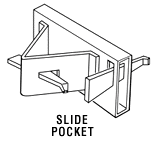
Sliding nose form
A metal concrete pouring form manufactured with a sliding nose piece
that retracts to allow adjacent forms to be removed from the pour without
removing forms from either side of the form with the sliding nose. Using
this type of form is the only way forms can be easily removed from a
pour when using pouring dowels or rebar. See fixed
nose form and rebar.
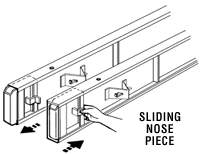
Slip form
A form which is raised or pulled as concrete is placed; may move vertically
to form wails, stacks, bins or silos, usually of uniform cross section
from bottom to top; or a generally horizontal direction to lay concrete
evenly for highways, on slopes and inverts of canals, tunnels, and siphons.
Slip forming
The process of simultaneously extruding and finishing concrete pavement,
curb and gutter combinations, median barriers, and like applications
using a paving machine. See paving
machine.
Building multi-story sitecast concrete walls with forms that rise up
as the wall construction progresses. See sitecast
concrete.
Slope
The incline angle of a sidewalk or road surface, given as a ratio of
the rise (in inches) to the run (in feet). See pitch.
Slump
The "wetness" of concrete. A 3 inch slump is dryer and stiffer than
a 5 inch slump. See slump cone, slump loss, and slump test.
Slump cone
A mold in the form of the lateral surface of the frustum of a cone
with a base diameter of 8" (203 mm), top diameter 4" (102 mm), and height
12" (305 mm), used to fabricate a specimen of freshly mixed concrete
for the slump test. A cone 6" (152 mm) high issued for tests of freshly
mixed mortar and stucco. See slump, slump
loss, and slump test.
Slump loss
The amount by which the slump of freshly mixed concrete changes during
a period of time after an initial slump test was made on a sample or
samples thereof. See slump, slump
cone, and slump test.
Slump test
This is a test to determine the plasticity of concrete. A sample of
wet concrete is placed in a cone-shaped container 12" high. The cone
is removed by slowly pulling it upward. If the concrete flattens out
into a pile 4" high, it is said to have an 8" slump. This test is done
on the job site. If more water is added to the concrete mix, the strength
of the concrete decreases and the slump increases. See Kelly
ball, slump, slump cone,
and slump loss.

Slurry
A mixture of water and any finely divided insoluble material, such
as Portland cement, slag, or clay in suspension. See Portland
cement.
Sonotube
A round, large cardboard tube designed to hold wet concrete in place
until it hardens.
Spall
A fragment, usually of flaky shape, detached from a larger mass by
pressure, expansion from within the larger mass, a blow, or by the action
of weather.
Spalling
The chipping or flaking of concrete, bricks, or other masonry where
improper drainage or venting and freeze/thaw cycling exists. See spaul,
spauling or spauled concrete.
Spaul, spauling or spauled concrete
The unwanted condition when small surface sections of a concrete slab
peel off or chip away. This condition due to the over use of salt, numerous
freeze/thaw cycles, or an inferior concrete mix. Same as spalling.
Specifications or Specs
A narrative list of materials, methods, model numbers, colors, allowances,
and other details which supplement the information contained in the
blue prints. Written elaboration in specific detail about construction
materials and methods. Specs are written to supplement working drawings.
Spring Steel
A high alloy metal that will spring back to its original shape after
being formed or bent into another shape. It is often used to manufacture
flexible forms. See flexible
forms.
Squeegee
Fine pea gravel used to grade a floor, normally before concrete is
placed. See placement.
Stacking
A metal angle, welded to metal forms and nailed to wood forms, that
helps secure the form in place when a form pin is driven through the
pocket and anchored by small metal wedges designed into the pocket.
See curb and gutter
forms, form pins,
straight form, flexible
form, nail stakes,
super flat forms, and transition
forms.
Stake
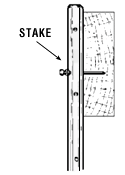 A
short, pointed piece of wood or metal driven into the ground as a marker
or an anchor. A
short, pointed piece of wood or metal driven into the ground as a marker
or an anchor.
Often used with wood or metal forms to anchor them into place during
concrete placement.
See cold-rolled
solid steel form pins, form
pins, flat stakes,
flatwork forms,
hot-rolled
solid steel form pins, and nail
stakes.
Stake pockets
"V" shaped components that are welded to the back of straight forms
or riveted to the back of flexible forms. A forming stake or pin is
inserted in the “V", hammered into the ground to anchor the form
securely, and held in place with a wedge. See flexible
forms and straight forms.
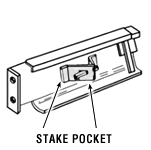
Stake puller
A metal device which acts as a fulcrum with a pivot that is used to
remove metal stakes hammered into the ground to secure wooden or metal
concrete forms.
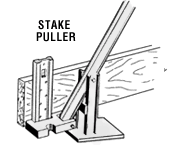
Steam curing
Curing of concrete or mortar in water vapor at atmospheric or higher
pressures and at temperatures between about 100° and 420° F
(40° and 215° C).
Steel trowel
A smooth concrete finish obtained with a steel trowel. It is also a
tool used for non-porous smooth finishes of concrete. It is a flat steel
tool used to spread and smooth plaster, mortar or concrete. Pointing
trowels are small enough to be used in places where larger trowels will
not fit. The pointing trowel has a point. The common trowel has a rectangular
blade attached to a handle. For a smooth finish, the steel trowel is
used when the concrete begins to stiffen. See trowel.
Steel troweling
A steel hand tool or machine used to create a dense, smooth finish
on a concrete surface. See troweling.

Straight filler forms
A metal form used to fill in sections in concrete placements where
a form length of less than 10'is needed for any flatwork application.
Straight filler forms are designed to slip over the top rails of the
forms to be joined. These forms are sometimes referred to as rehab forms.
See flatwork forms
and straight forms.
Straight forms
Formed metal channels, typically 10 feet long, with a height that varies
from 4" to 24" and used for straight concrete forming and pours. The
width of the base can vary between 2" and 4" dependent on form height
and application. The top rail of the form is typically 2" wide. Applications
for straight forms include, front and back form for curb and gutter
setups, sidewalks, patios, retaining walls, foundation footers, and
similar applications. See corner
forms, filler forms,
flexible forms,
keyway forms, radius
forms, reversible
forms, tilt-up forms,
tilt-up reversible
forms, and transition
forms.
Straightedge
A rigid and straight, piece of wood or metal used to strike off or
screed a concrete surface to the proper grade, or to check the flatness
of a finished grade. See also rod,
screed, and strike off.
Strategic Highway Research Program (SHRP)
A research program designed to produce better techniques and materials
in the areas of concrete structures, asphalt, pavement performance,
and highway operations.
Strike off
To remove concrete in excess of that which is required to fill the
form evenly or bring the surface to grade, performed with a straight-edged
piece of wood or metal by means of a forward sawing movement or by a
power-operated tool appropriate for this purpose. The name applied to
the tool used to fill the form evenly. See screed.
Stripping
Removing the formwork from concrete. See formwork.
Stripping agent
See release agent.
Stucco
Refers to an outside plaster finish made with Portland
cement as its base.
Sub-base
Clay or soil material used underneath the stone base. See base
course / base.
Subcontractor
A contractor who specializes in one area of construction activity and
who usually works under the general contractor. See contractor
and general contractor.
Super flat floor
A concrete slab finished to a high degree of flatness according to
recognized systems of measurement.
Super flat forms
Forms designed to prevent "screed hop" when a rock or other debris
is on the form rail and causes the screed bar to hop which creates a
ripple in the pour. This ripple typically must be ground out. Super
flat forms have a knife edge upon which the screed rides and causes
rocks or debris sitting on the form rail to be pushed out of the way
of the screed bar ensuring a flat pour. See form
rail.
Superplasticizer
A concrete admixture that makes wet concrete extremely fluid without
additional water. These agents perform the same function as a plasticizer,
but are composed of different materials. See admixture
and plasticizer.
Surface moisture
Free moisture retained on the surfaces of aggregate particles that
becomes part of the mixing water in the concrete mix. See aggregate.
Swirl finish (sweat finish)
A nonskid texture imparted to a concrete surface during final troweling
by keeping the trowel flat and using a rotary motion. See trowel,
troweling, and trowel
finish.
A | B | C | D | E | F | G | H | I | J | K | L | M
N | O | P | Q | R | S | T | U | V | W | XYZ

|
![]()